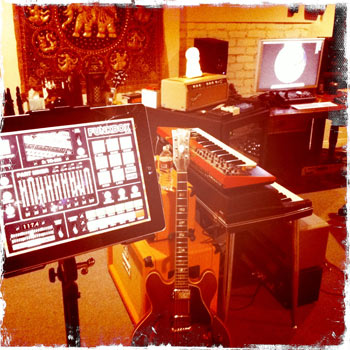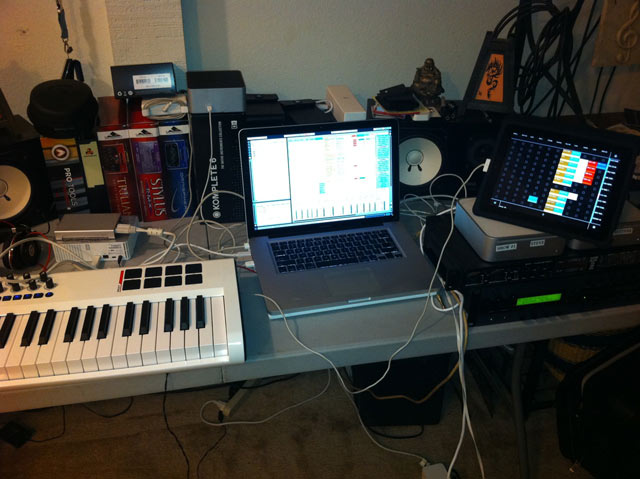Premier
Guitar, Jun '11 - How to Use iPad Like a Pro Gutarist
by Jim
McGorman
Everyone
knows the iPad is changing the face of media and music. To date the
iPad has sold 25 million units, paid $2.5 billion to software
developers for apps, and sold 130 million iBooks— according to Apple’s
latest announcements made from the World Wide Developers Conference in
San Francisco on June 6, 2011.
Let’s not forget the iPad’s importance—and usefulness—for professional
musicians. For many, it’s like the reinvention of the wheel. The iPad
has revolutionized how musicians—myself included—approach practice,
rehearsal, recording, and live shows.
 Jim's studio, anchored by the iPad
Jim's studio, anchored by the iPad
As a professional musical director, producer, and musician, my days are
hectic. An average morning for me includes running through a rehearsal
with Avril Lavigne at 11 a.m., then running across Los Angeles to a
studio session with Weezer in the late afternoon. Because I am always
hustling to fit every ounce of rock in, I always have to make sure I
have my keys, shades, phone—and now, my iPad.
In preparation for Avril Lavigne’s latest world tour supporting Goodbye
Lullaby, I used the iPad extensively in rehearsals. As Avril’s
musical director, it is important for me to have all of her music at my
fingertips—and easily accessible—so I load every one of her new and old
tracks onto the built-in iPod. I also use Notes to jot down thoughts or
ideas, and I import or create lyrics with the Pages app. The iPad is
always on a stand next to my pedalboard—far easier than walking over to
a computer all the time.
The iPad can also be a lifesaver when working out new material in
rehearsals. As musical director for Weezer, we were working on a cover
version of Radiohead’s “Paranoid Android.” I brought the iPad to the
studio to access the Radiohead recording, as well as several live
versions I pulled up on YouTube. With five guys set up in normal
playing positions, I bring the iPad around to each of them and play
them a riff from iTunes, or show them a YouTube clip without anyone
having to get up and walk around to me.
The iPad is popping up in other high profile, real-world applications
as well. Paul Mirkovich, musical director for Pink, Cher, Christina
Aguilera, and Janet Jackson, uses the iPad in rehearsals and live
onstage for the new hit CBS show The Voice.
“I use the iPad extensively on The Voice during rehearsals. I
use the GoodReader app to read all the PDF charts I have for the show,
which is almost 160 songs at this point,” said Mirkovich. “I also use
it for personal playback, and looking up live versions of the songs we
do on YouTube. The iPad is an indispensable piece of gear and is always
on the stand with me.”
The Guitarist
Of course, there are multitudes of applications for guitarists not in
charge of major productions as well. There is a wealth of
guitar-specific apps [as covered previously in Premier Guitar’s
"The Guitarist's Guide to iPad Apps"] that
simplify and enhance life as a guitarist. They let you record, stay in
tune, learn, and capture ideas. And some push you to approach the
instrument in a whole new way.
Ryan James Cheung, a musician from Winnipeg, said “As a guitarist and
bassist, the most interesting aspect of using something like the
virtual guitars in GarageBand is that you play the onscreen guitar more
like a piano than a guitar. What I like about this is that it breaks
the conventional techniques we guitarists usually employ on the guitar,
once we transfer what we have written on the iPad, to an actual guitar.”
Among guitar-specific apps, I find that AmpliTube iRig is essential. It
allows you to plug in and play your guitar through choices of amps,
cabs, speakers, and effects. The sound quality is superb and the app
itself is instantly inspiring. For tuning, TuneORama is one of the most
accurate stand-alone tuners available. It has guitar and chromatic
tuner mode, which is perfect for tuning instruments like mandolin and
violin (and is a great value at $2.99). For capturing ideas on the fly,
BPM is a great app for taping out a tempo. The built-in Voice Memos
Recorder is indispensable for getting an idea down quickly, before it
falls into the abyss of “Man, what was that awesome lick I came up with
the other day?”
The Road Dog
Though there are thousands of music-specific apps, some of the more
general apps can be a lifesaver for touring musicians. I probably use
Facetime more than any other app. You can video call anyone who has an
iPhone, iPad, or any Apple computer with a camera over WiFi. The
quality is dependent on your WiFi connection, but in most cases, it has
worked flawlessly for me. Recently, I had a video chat from Cologne,
Germany with a friend who was driving on the freeway up the East Coast
in the US. With long distance phone charges at a premium, Facetime
saves me a ton of cash. Psychologically, it’s a great feeling to be
able to see the people I love anytime I want—without worrying about
coming home to a massive phone bill.

Another reality of touring today is the importance of staying
up-to-date with social media—it’s crucial for musicians because you
need to get people to the shows. Guitarists and bands can use Twitter,
Facebook, and Ustream on the iPad to promote upcoming events on the
road, without needing to stop by a coffee shop or hotel to jump onto
WiFi. When you get into a heated debate with bandmates in the back of
the bus or van about who played the solo on Steely Dan’s “My Old
School,” the iPad has the answer in seconds. It’s the little things
that count on the road.
The iPad helps touring musicians in other ways too. FlightTrack Pro is
perfect for managing flights for gigs with to-the-minute information on
delays, gates, and flight duration. And the SeatGuru app provides
valuable info for securing the primo seats on any type of aircraft.
The Producer or Studio Musician
The iPad also creates an innovative way to collaborate with other
musicians who may not be living near you, and to make life in the
studio easier.
As a producer, I have used Facetime for writing and pre-production
sessions with clients remotely. I am based in LA, and have worked with
people virtually through Facetime in Connecticut, New Jersey, Florida,
and even Canada. When I am on the road, I can communicate with my
engineer back at my LA studio by sending mixes, files, and notes
through Dropbox or emails.
Producer Matt Chirichillo says, “To me, the iPad is a form of
inspiration on the go. I use it to construct loops and put grooves
together. It’s like having a travel size sequencer at your fingertips.”
DJ and producer Tom Colontonio uses the iPad to “scratch pad ideas.”
Colontonio uses Studio Pro for full WAV file editing, and he stresses
the fact that “The iPad rules,” for DJs in the digital realm.
In addition, musicians are using the iPad to replace sheet music. The
BT-105 Bluetooth wireless page turner from AirTurn allows you to
control the turning of pages wirelessly from a foot switch. It’s
especially useful for guitarists who need to keep both hands on their
instrument while using apps for reading sheet music and guitar tabs.
Classical musicians who use sheet music live can use the iPad to play
entire symphonies and operas without ever having to turn a page.
Instead of breaking rhythm, they can fluidly play through a piece of
music simply by tapping the switch with their foot.
Live Onstage
Finally, in addition to use during preparation for shows, many
musicians are using the iPad while playing live. Steve Ferlazzo, the
keyboardist and programmer for Avril Lavigne, uses the iPad as a VNC
controller/front-end for the computers. It eliminates the need for a
separate screen, keyboard, and mouse for him. Ferlazzo uses a custom
app called GriidRed by Liine, which enables the iPad to control and
manipulate clips and data in Ableton Live. The units are synched via
WiFi on a private network.
“The iPad allows me to focus more on performance, as opposed to
computer-related tasks. It's a seamless process,” says Ferlazzo. “It's
all right in front of me at my fingertips. After using the iPad in a
live setting where computers are a requirement, it's hard to imagine it
not being a permanent piece in my workflow.”
The iPad was released in 2009 to massive success. Though it seemed to
have amazing possibilities for music, no one really knew how the iPad
would be used in every day musical applications. In 2011, the iPad has
not only become a mainstay in studios and on stages all over the world,
it is an indispensable tool that musicians can’t live without.
|

